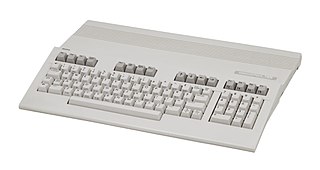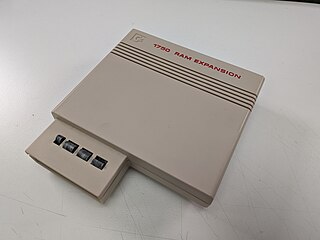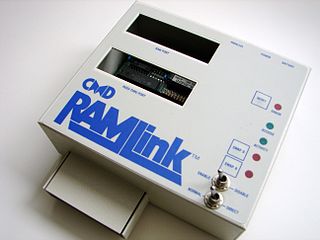
The Commodore 1541 is a floppy disk drive which was made by Commodore International for the Commodore 64 (C64), Commodore's most popular home computer. The best-known floppy disk drive for the C64, the 1541 is a single-sided 170-kilobyte drive for 5¼" disks. The 1541 directly followed the Commodore 1540.

The Commodore 1581 is a 3½-inch double-sided double-density floppy disk drive that was released by Commodore Business Machines (CBM) in 1987, primarily for its C64 and C128 home/personal computers. The drive stores 800 kilobytes using an MFM encoding but formats different from the MS-DOS, Amiga, and Mac Plus formats. With special software it's possible to read C1581 disks on an x86 PC system, and likewise, read MS-DOS and other formats of disks in the C1581, provided that the PC or other floppy handles the "720 kB" size format. This capability was most frequently used to read MS-DOS disks. The drive was released in the summer of 1987 and quickly became popular with bulletin board system (BBS) operators and other users.

The Commodore 64, also known as the C64, is an 8-bit home computer introduced in January 1982 by Commodore International. It has been listed in the Guinness World Records as the highest-selling single computer model of all time, with independent estimates placing the number sold between 12.5 and 17 million units. Volume production started in early 1982, marketing in August for US$595. Preceded by the VIC-20 and Commodore PET, the C64 took its name from its 64 kilobytes(65,536 bytes) of RAM. With support for multicolor sprites and a custom chip for waveform generation, the C64 could create superior visuals and audio compared to systems without such custom hardware.

The Commodore 1570 is a 5¼" floppy disk drive for the Commodore 128 home/personal computer. It is a single-sided, 170 kB version of the Commodore 1571, released as a stopgap measure when Commodore International was unable to provide sufficient quantities of 1571s due to a shortage of double-sided drive mechanisms. Like the 1571, it can read and write both GCR and MFM disk formats. The 1570 utilizes a 1571 logic board in a cream-colored original-1541-like case with a drive mechanism similar to the 1541's except that it was equipped with track-zero detection. Like the 1571, its built-in DOS provides a data burst mode for transferring data to the C128 computer at a faster speed than a 1541 can. Its ROM also contains some DOS bug fixes that didn't appear in the 1571 until much later. The 1570 can read and write all single-sided CP/M-format disks that the 1571 can access.

The Commodore 128, also known as the C128, C-128, or C= 128, is the last 8-bit home computer that was commercially released by Commodore Business Machines (CBM). Introduced in January 1985 at the CES in Las Vegas, it appeared three years after its predecessor, the Commodore 64, the bestselling computer of the 1980s. Approximately 2.5 million C128s were sold during its four year production run.

The Commodore Plus/4 is a home computer released by Commodore International in 1984. The "Plus/4" name refers to the four-application ROM-resident office suite ; it was billed as "the productivity computer with software built in".

The Commodore 65 is a prototype computer created at Commodore Business Machines in 1990–1991. It is an improved version of the Commodore 64, and it was meant to be backwards-compatible with the older computer, while still providing a number of advanced features close to those of the Amiga.

The Commodore SX-64, also known as the Executive 64, or VIP-64 in Europe, is a portable, briefcase/suitcase-size "luggable" version of the popular Commodore 64 home computer and the first full-color portable computer.

The Commodore RAM Expansion Unit (REU) is a range of external RAM add-ons.

The Commodore CBM-II series is a short-lived range of 8-bit personal computers from Commodore Business Machines (CBM), released in 1982 and intended as a follow-on to the Commodore PET series.
BASIC 8 – "The Enhanced Graphics System For The C128" – was an American-designed graphics system developed by Walrusoft of Gainesville, Florida and published in 1986 by Patech Software of Somerset, New Jersey. The system was an extension of Commodore's BASIC 7.0 for the C128 home/personal computer. BASIC 8.0 provided commands lacking in BASIC 7.0 to generate (color) graphics in the C128's high-resolution 80-column mode for RGB monitors.

GEOS is a discontinued operating system from Berkeley Softworks. Originally designed for the Commodore 64 with its version being released in 1986, enhanced versions of GEOS later became available in 1987 for the Commodore 128 and in 1988 for the Apple II series of computers. A lesser-known version was also released for the Commodore Plus/4.

The RAMLink was one of several RAM expansion products made by Creative Micro Designs (CMD) for Commodore's C64/128 home computers. The RAMLink was intended as a third-party alternative, successor and optionally companion to Commodore's own 17xx-series REU RAM expansion cartridges.

The Commodore 64 home computer used various external peripherals. Due to the backwards compatibility of the Commodore 128, most peripherals would also work on that system. There is also some compatibility with the VIC-20 and Commodore PET.

A fast loader is a software program for a home computer, such as the Commodore 64 or ZX Spectrum, that accelerates the speed of file loading from floppy disk or compact cassette.
The CMD FD series was Creative Micro Designs (CMD)'s range of third-party floppy disk drives for the Commodore 8-bit line of home computers. Using 3½" floppy disks, they provided a significantly larger storage capacity than Commodore-produced drives; the FD-2000 offered 1600 kB of storage using standard double-sided, high-density floppies, while the FD-4000 also allowed the use of 3200 kB extra-high density (ED) floppies. In contrast, the Commodore 1581 3½" drive only supported 800 kB double-sided, double-density disks.
The SuperCPU is a processor upgrade for the Commodore 64 and Commodore 128 personal computer platforms. It uses the W65C816S 8/16 bit microprocessor, and takes the form of an expansion port cartridge, rather than a replacement for the 6510 CPU.
IDEDOS is a ROM-based disk operating system written in 6502/65816 assembly language for the Commodore 64, 128 and SuperCPU. Its main purpose is to control ATA(PI) devices connected to an IDE64 cartridge and present them like normal Commodore drives. Additionally it supports networked drives (PCLink) and has a built-in machine code monitor and file manager.
Commodore 64 disk/tape emulation and data transfer comprises hardware and software for Commodore 64 disk & tape emulation and for data transfer between either Commodore 64 (C64), Commodore (1541) disk drive or Commodore tape deck and newer computers.

1541 Ultimate is a peripheral, primarily an emulated floppy disk and cartridge emulator based on the FPGA Xilinx XC3S250E, for the Commodore 64 home computer. It became available in 2008.















